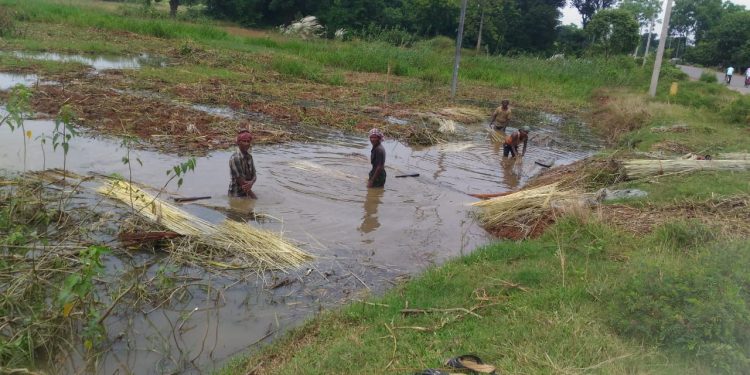Hatadihi: At one point of time, Odisha was among the major jute producers in the country. However, with no government patronage, the farmers in Keonjhar district are turning away from the crop.
Expressing concern over the dilly-dallying attitude of the State government and the neglect of the traditional crop, jute farmers of Akarua, Ambagadia and Hatadihi panchyat under Hatadihi block have declared that they were forced to give up jute farming.
As bio-degradable material, jute is used to prepare carpets, sacks, ropes and other household articles. It is also widely used as fuel in rural areas.
Distress sale of raw jute, inadequate marketing facility for jute fibre and other products in the absence of government patronage are some of the major problems affecting the farmers. Hence they are not interested to continue dealing in jute.
About 500 families of the block are engaged in jute farming which needs hot and humid climate. It requires temperature between 24°C and 35°C and heavy rainfall of 120 to 150 cm with 80 to 90 per cent relative humidity during the period of its growth.
Jute is generally sown in February in the lowlands and in March-May on the uplands. The crop takes nearly 10 months to mature but the various varieties need different time frames to mature. The harvesting period starts in July and continues till October.
Jute plants are cut to the roots and tied into bundles. Sheaves of jute stocks are then immersed in stagnant water or ponds for about a couple of weeks for rotting. High temperature of water quickens the process of retting. Afterwards, the bark is peeled from the plant and fibre is removed.
Subsequently, stripping, rinsing, washing and cleaning is done and the fibre is dried in the sun and pressed into bales. The entire process is done manually and requires cheap labour and cultivated in areas of high population density.
To produce eight quintals of jute a farmer needs Rs 14, 000 to Rs 16, 000. But he sells a bundle of jute for just Rs 15 to Rs 20.
However, the State Government has not done anything substantial to promote jute farming. Surprisingly, it has made no provision for jute either in its annual budget or agricultural policy.
As a result, jute production has gone down substantially in the state, according to an Agriculture Department report.
An agricultural department report said, jute was cultivated in 7.56 hectares in FY 2014-15, 5.63 ha in FY 2015-16, 3.88 ha in FY 2016-17, 4.37ha in FY 2017-18 and 3.99ha in FY 2018-19.
The United Nations has been emphasizing on the use of jute products instead of plastic to protect the environment.
PNN







































